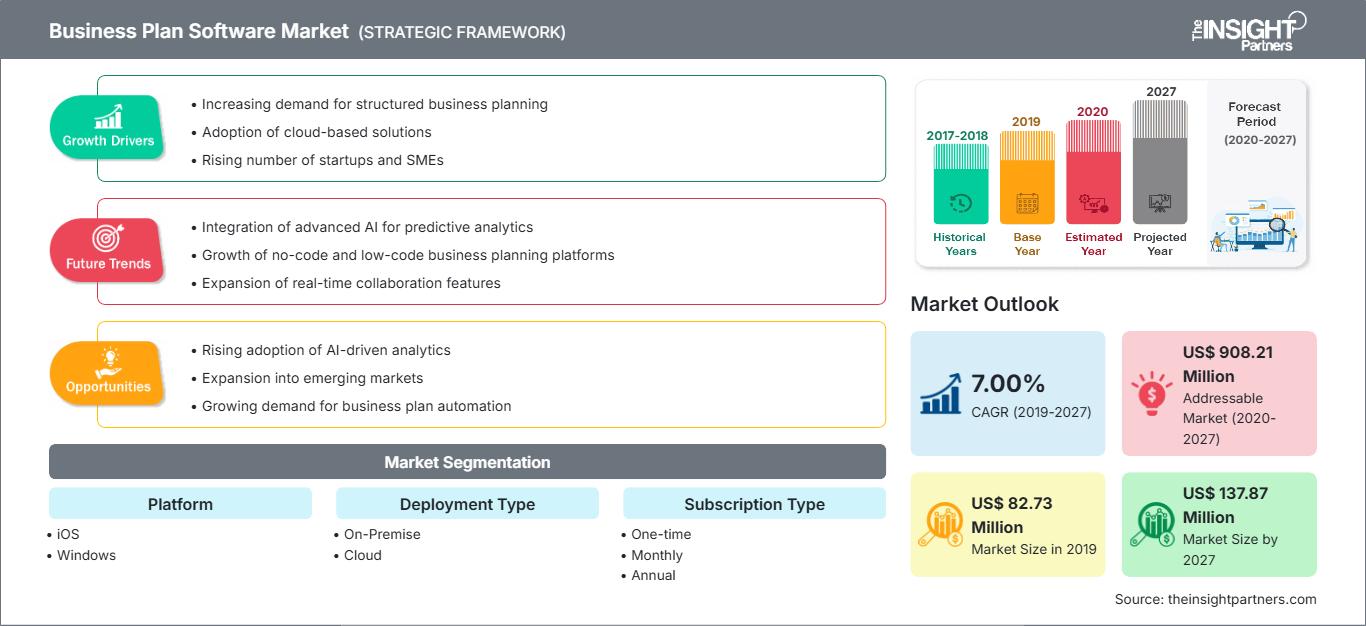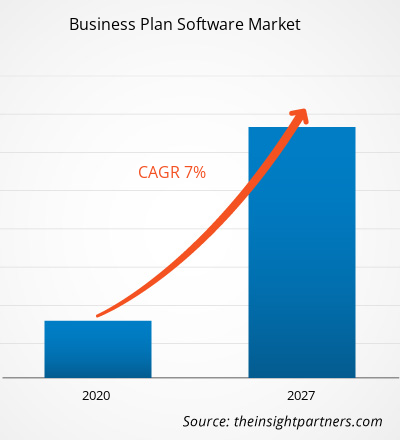Le marché des logiciels de business plan était évalué à 82 730,3 milliers de dollars américains en 2019 et devrait atteindre 13 787,14 milliers de dollars américains d'ici 2027. Le marché des logiciels de business plan devrait croître à un TCAC de 7,00 % entre 2020 et 2027.
Le marché des logiciels de business plan gagne en importance au fil des ans à l'échelle mondiale. Tant les pays développés que les pays en développement connaissent une croissance significative du nombre de start-ups émergentes dirigées par des entrepreneurs férus de technologie. La demande de logiciels de business plan est maximale parmi les nouveaux entrepreneurs des pays développés ; cependant, ces derniers prennent conscience des avantages des logiciels de business plan basés sur des logiciels. Cela catalyse la croissance du marché des logiciels de business plan. Les logiciels de business plan disponibles sur le marché sont également utilisés par plusieurs cabinets de conseil proposant des services de planification d'entreprise. Ces cabinets de conseil rencontrent chaque année un grand nombre d'entrepreneurs à la recherche de plans d'affaires solides dans tous les secteurs. Face à la demande croissante de business plans dans divers secteurs d'activité, les cabinets de conseil optent pour des solutions logicielles qui leur offrent un large éventail d'exemples de business plans. Cela leur permet de conquérir une vaste clientèle et de payer l'abonnement. Ce facteur stimule la croissance du marché des logiciels de business plans.
Si les points de vue divergent quant aux dommages potentiels de la COVID-19, il n'en demeure pas moins que la maladie se propage dans le monde entier. Le nombre de nouveaux cas augmente notamment aux États-Unis, au Canada, en Europe, en Afrique, au Moyen-Orient, en Inde, en Australie, en Corée du Sud et au Japon. Si les impacts sur diverses entreprises sont bien connus, le secteur technologique est également confronté à la plus grande perturbation de ces dernières années.
Le marché mondial des logiciels de business plans est segmenté selon des paramètres tels que la plateforme, le type de déploiement, le type d'abonnement et la géographie. Selon la plateforme, le marché a été classé comme iOS, Windows et autres. Le segment du type de déploiement a été divisé en deux : sur site et cloud. Les abonnements sont classés en forfaits uniques, mensuels et annuels. Géographiquement, le logiciel de business plan est segmenté comme suit : Amérique du Nord, Europe, Asie-Pacifique (APAC), Moyen-Orient et Afrique (MEA) et Amérique du Sud (SAM).
Vous bénéficierez d’une personnalisation sur n’importe quel rapport - gratuitement - y compris des parties de ce rapport, ou une analyse au niveau du pays, un pack de données Excel, ainsi que de profiter d’offres exceptionnelles et de réductions pour les start-ups et les universités
Marché des logiciels de business plan: Perspectives stratégiques

-
Obtenez les principales tendances clés du marché de ce rapport.Cet échantillon GRATUIT comprendra une analyse de données, allant des tendances du marché aux estimations et prévisions.
La croissance fulgurante de l'industrialisation mondiale résulte de l'augmentation du nombre de start-ups, de petites et moyennes entreprises (PME) et de grandes organisations dans tous les secteurs. L'écosystème des start-ups est actuellement en plein essor dans le monde entier et stimule l'économie de tous les pays. Les nouveaux entrepreneurs recherchent des services de business plan pour évaluer leurs perspectives commerciales. La majorité des entrepreneurs émergents des pays développés étant conscients des avantages des logiciels de business plan, la demande de logiciels de business plan parmi les entreprises fournissant des services de business plan est en plein essor. Ce paramètre influence positivement la croissance du marché des logiciels de business plan.
Analyse du marché des plateformes
Les entreprises de développement de logiciels de business plan se concentrent fortement sur le développement de leurs produits pour différentes plateformes. Les logiciels iOS, Windows, Linux et web sont disponibles en abondance pour aider les nouveaux entrepreneurs ou les nouveaux chefs d'entreprise à déterminer et à évaluer leur stratégie commerciale. Les autres segments (web et Linux) dominent le marché des logiciels de business plan, suivis par Windows et iOS.
Analyse du marché basée sur le type de déploiement
Les logiciels de business plan cloud, ainsi que les logiciels de business plan sur site, gagnent en popularité auprès des nouveaux entrepreneurs et des cabinets de conseil proposant des services de business plan. Le cloud génère la majeure partie de la demande, car il est comparativement moins coûteux et bénéficie d'une infrastructure réseau solide dans les pays développés. De plus, les développeurs de logiciels de business plan se concentrent fortement sur la conception de correctifs de sécurité de haut niveau afin d'éliminer les risques de cyberattaque. Ce facteur crée également une demande importante de la part des utilisateurs finaux, stimulant ainsi le marché des logiciels de business plan.
Analyse du marché basée sur le type d'abonnement
L'écosystème mondial des start-up est en plein essor, et chaque nouveau propriétaire d'entreprise recherche une feuille de route commerciale adaptée. Cela a entraîné une augmentation du nombre de développeurs de logiciels de business plan dans le monde entier. Ces développeurs proposent leurs produits sur la base d'abonnements, tels que des abonnements uniques, mensuels et annuels. La demande pour chacun des types d'abonnements mentionnés ci-dessus est en constante augmentation parmi les différents utilisateurs finaux. Le segment des abonnements annuels domine le marché des logiciels de business plan, suivi par les abonnements uniques et mensuels.
Les acteurs du marché des logiciels de business plan se concentrent sur des stratégies telles que les initiatives commerciales, les acquisitions et les lancements de produits pour maintenir leur position. Voici quelques développements réalisés par des acteurs clés du marché :
En février 2019, Upmetrics Business Planner est là pour vous aider. Cette plateforme simplifiée et tout-en-un permet aux clients de créer des business plans personnalisés, d'élaborer des projections financières et bien plus encore. Un abonnement à vie est actuellement disponible rapidement et facilement avec une réduction de plus de 95 % pour seulement 24,99 $.
Marché des logiciels de business planLes tendances régionales et les facteurs influençant le marché des logiciels de business plan tout au long de la période de prévision ont été analysés en détail par les analystes de The Insight Partners. Cette section aborde également les segments et la répartition géographique du marché des logiciels de business plan en Amérique du Nord, en Europe, en Asie-Pacifique, au Moyen-Orient et en Afrique, ainsi qu'en Amérique du Sud et en Amérique centrale.
Portée du rapport sur le marché des logiciels de planification d'affaires| Attribut de rapport | Détails |
|---|---|
| Taille du marché en 2019 | US$ 82.73 Million |
| Taille du marché par 2027 | US$ 137.87 Million |
| TCAC mondial (2019 - 2027) | 7.00% |
| Données historiques | 2017-2018 |
| Période de prévision | 2020-2027 |
| Segments couverts |
By Plateforme
|
| Régions et pays couverts |
Amérique du Nord
|
| Leaders du marché et profils d'entreprises clés |
|
Densité des acteurs du marché des logiciels de business plan : comprendre son impact sur la dynamique des entreprises
Le marché des logiciels de business plan connaît une croissance rapide, porté par une demande croissante des utilisateurs finaux, due à des facteurs tels que l'évolution des préférences des consommateurs, les avancées technologiques et une meilleure connaissance des avantages du produit. Face à cette demande croissante, les entreprises élargissent leur offre, innovent pour répondre aux besoins des consommateurs et capitalisent sur les nouvelles tendances, ce qui alimente la croissance du marché.
- Obtenez le Marché des logiciels de business plan Aperçu des principaux acteurs clés
- Sur site
- Cloud
Marché des logiciels de plan d'affaires - par plateforme
- Windows
- iOS
- Autres
Marché des logiciels de plan d'affaires - par type d'abonnement
- Unique
- Mensuel
- Annuel ... par géographie
-
Amérique du Nord
- États-Unis
- Canada
- Mexique
-
Europe
- France
- Allemagne
- Russie
- Royaume-Uni
- Italie
- Reste de l'Europe
-
Asie Pacifique (APAC)
- Chine
- Inde
- Japon
- Australie
- Reste de l'APAC
-
MEA
- Arabie Saoudite
- EAU
- Afrique du Sud
- Reste du MEA
-
SAM
- Brésil
- Argentine
- Reste de SAM
Marché des logiciels de plan d'affaires - Profils d'entreprise
- Atlas Business Solutions, Inc.
- enloop, Inc.
- Palo Alto Software, Inc.
- PlanGuru, LLC
- Simpleplanning
- Startups.com LLC
- StratPad Inc.
- Tarkenton.com
- La boutique de plans d'affaires Ltd.
- UpMetrics
-
- Analyse historique (2 ans), année de base, prévision (7 ans) avec TCAC
- Analyse PEST et SWOT
- Taille du marché Valeur / Volume - Mondial, Régional, Pays
- Industrie et paysage concurrentiel
- Ensemble de données Excel
Rapports récents
Rapports connexes
Témoignages
Raison d'acheter
- Prise de décision éclairée
- Compréhension de la dynamique du marché
- Analyse concurrentielle
- Connaissances clients
- Prévisions de marché
- Atténuation des risques
- Planification stratégique
- Justification des investissements
- Identification des marchés émergents
- Amélioration des stratégies marketing
- Amélioration de l'efficacité opérationnelle
- Alignement sur les tendances réglementaires






















 Obtenez un échantillon gratuit pour - Marché des logiciels de business plan
Obtenez un échantillon gratuit pour - Marché des logiciels de business plan